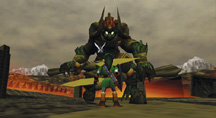
Video Gaming is a way of life for millions. I’m one of them.
by Daniel Manning
I am a racecar driver.
I am a swordsman.
I am a gangster.
I am an alien.
I have saved the world.
I have played in front of thousands.
I have found the princess in another castle.
I have found the cake.
I have done all of this from my basement.
I am one of millions of explorers in the strange world of video games. Among my fellow gamers, I am young at 18. The average gamer is 35, according to the Entertainment Software Association, and has been playing for 12 years.
We’re disciples of technology. With the immense amount of processing power in today’s computers — your cell phone is at least as advanced as the many of the computers in the Space Shuttle — we’re dedicated to using them for fun.
In honor of the 30th anniversary of Pac-Man — and attentive to the upcoming Supreme Court decision on whether video games need more regulation — Bay Weekly takes a look into this (older-than-you-think) genre.
Hey! Listen!
Technology and fun drive video games. The fun of my first game, Pokémon Yellow, was catching these monsters and training them to become the best they can be.
Back then, in 2000, video games were on their fifth generation, far past the advancement of Pong, which simplified table tennis to two bars and a dot.
Pong was influential, but Pong wasn’t the original video game. Released in 1972, it marked the beginnings of video games as a lucrative business, but their history begins far earlier.
The first original influential video game in a strict sense — an electronic game with a screen — was Spacewar!, an exuberantly titled game programmed by early electronic tinkerers at MIT in 1961.
Players control opposing space ships orbiting around a sun. As is appropriate for a game entitled Spacewar!, they fight.
War remains a common theme in video games, and it’s the extreme of that bellicosity that gets legislatures, and now the Supreme Court, into video gaming. But 92 percent of games are not much more violent than Pong. Only eight percent are M (for Mature) Rated titles. What keeps me and my fellow gamers playing is fun, not violence. We crave the same kind of escapism people seek in books and movies.
Games don’t necessarily tell stories better or worse than another medium, only differently. Through the past 40 years, each new generation of games has been able to tell a richer story, with more lifelike characters, richer music and technological mastery.

 Suddenly, the phantom’s sword lifts into the air,
Suddenly, the phantom’s sword lifts into the air,
and a ball of dark lightning flows from it.
He throws the ball at the hero, who uses his sword to deflect the volley,
sending it flying back. The phantom returns the favor.
The hero hits it back, and their throws go faster and faster
until the phantom can’t keep up.
The dark ball hits him, and he crumbles.
It’s Dangerous to Go Alone
To play the game, you’ve got to have a platform. Both computers and consoles do the job. The first console dedicated to video games was the Magnavox Odyssey, released in August 1972.
By 1977, the Atari 2600 kicked off gaming as a popular diversion. In the 2600, Atari — the company that had first produced Pong — created an advanced video game console that could play more than just an initial complement of games. The invention sold millions of units.
“When the Atari came out, it changed everything,” says Bay Weekly’s J. Alex Knoll, who grew up with that early generation of video games.
But the Nintendo Entertainment System, released in 1985, idealized the modern video game console. Most of its precedents are still alive today, including an iconic controller, consisting of a directional pad (four buttons arranged in cardinal directions) instead of a joystick. It also took partial control of third-party development; only licensed developers could make games. The Nintendo Seal of Quality is still used today. The NES also heralded the creation of many beloved series like the Mario Bros. games and The Legend of Zelda that inform the culture of gamers.
Odyssey was the first video game console, the Atari 2600 made video-game consoles a lucrative market, and the NES offered games that told complex stories, giving people shared experiences of that story and thereby creating gaming culture as we know it.


It has all come down to this. The plumber-turned-hero faces
the giant monster. The lava below heats him, beginning to burn.
The monster throws fire, easily dodged. The monster jumps up,
and Mario runs under him. He reaches the edge of the bridge and
grabs an ax from the wall. He chops the chain links holding the bridge
up, and the monster falls into lava. Finding the cells, Mario opens them.
Out runs the princess’ servant. “Sorry Mario! But our princess is in
another castle!”
A Man Chooses
We call video gaming a culture because it’s the society gamers like to belong in; but it’s a big culture, with room for many tastes.
It’s easy to find a niche, whether you like large, sweeping, single-player adventures or the unique interactions that a multi-player game offers.
There are puzzle games (Bejeweled, Tetris). There are first-person perspective shooter games, or FPS (Halo, Half-Life), where the players follow the story through the eyes of their character. There are role-playing games, RPG, (Final Fantasy, Mass Effect) where your character continuously develops over the course of the plot.
There are Massively Multiplayer Games (MMO), where all the players exist in a world at the same time (World of Warcraft, EVE Online). In the multiplayer realm, players can play competitively against others or in a group with friends to cooperatively challenge the game itself.
Naturally, there are sports games, emulating sports from football (American) to football (everywhere else), to golf. If there’s a sport, there’s a game. The Madden NFL series, for example, has a new iteration every year, with all of the updated team rosters.
The idea is escapism. Have you ever wanted to drive a Ferrari? Or become a traveling swordsman, saving kingdom and village alike? Games offer that rich experience in the same way a movie or a novel would.
Almost closer to a toy than a game are open-world games, which move the focus from a linear advancement of the plot, and instead give players a sandbox to work with (Crackdown, Grand Theft Auto). If the player does not choose to progress the story, that’s okay.

 Coming up on the front of the pack, the driver spots his prey, the car
Coming up on the front of the pack, the driver spots his prey, the car
in the lead, a red sports car with a black racing stripe. He fires a short
bolt at the lead car, a warning shot to get its driver ready to lose.
The car fishtails a bit as it is hit and clumsily takes the turn.
The second-place driver is ready to take the lead. He fires a large
ball of pulsing red plasma at the lead car, which is by now feebly
trying to keep straight. It is a direct hit, and the driver zooms past
the red car into first place.
Objection!
The Grand Theft Auto series puts players in one of these open worlds, where they follow the plot of a small-time gangster making it big in the city. The games tell complex stories, but they also let the players be exceptionally violent if they so choose.
Games like this are among the ultraviolent that routinely provoke state and federal gaming legislation. The Supreme Court is now deciding the constitutionality of a California law that would prevent minors from buying such “ultraviolent games.”
The California code in question states that “A person may not sell or rent a video game that has been labeled as a violent video game to a minor” and that “Each violent video game that is imported into or distributed in California for retail sale shall be labeled with a solid white ‘18’ outlined in black.”
The law does not prohibit minors from playing the game or prevent the sale of the games to others. Proponents argue that the violence is borderline pornographic, while opponents remind us that there is an independent rating system.
The ESRB rates games, and most retailers prevent M-rated (17+) games being sold to minors. The Xbox 360, PlayStation 3 and Wii all have parental controls, keeping informed parents from exposing their children to games that mom and dad find objectionable.
A developer at Rockstar, the company that develops the Grand Theft Auto series, said “Our games are not designed for young people. If you’re a parent and buy one of our games for your child, you’re a terrible parent.”
The question being asked by the Supreme Court is Who should determine what children play? Should the state decide, or should parents?

 The Lone Wanderer walked out of the shanty and silently
The Lone Wanderer walked out of the shanty and silently
moved through the city. It was mostly abandoned, but the residents
left were bad news. He saw the crumbling tower used to broadcast
Galaxy Nation Radio, and he knew that turning it back on was the
only way to find his father. He knew that the tower used to be some
kind of monument for someone important. He used the still-working
elevator to reach the top and installed the satellite dish. The GNR
broadcast came in clear. Out in the distance, he could see the remains
of the Capitol and the excavated Mall.
All Your Base
The ancestral home of video game controversy — the darkened video arcade and Chuck-E.-Cheese pizza parlor (founded by Nolan Bushnell, who originally founded Atari) — belong to an earlier age. The arcade business in America is falling apart due to cheaper and more powerful consoles.
Three platforms dominate the seventh technological generation of video-gaming:
• The Microsoft Xbox 360 (the second iteration of the Xbox line);
• The Sony PlayStation 3 (ostensibly, their third upgrade); and
• The Nintendo Wii (the fifth Nintendo console).
Portable consoles include the Nintendo DS and the Sony PlayStation Portable. You can also play on your computer, which gives you the benefit of a mouse and keyboard, friendlier to quick movement.
In sales, the Wii is in the lead, due to a price point lower than its competitors ($250) and its ease of use. The Wii eschews the traditional game pad in favor of a motion-tracking device that is less intimidating than others to a non-gamer, with only a directional pad and six buttons, one reserved for the system. Additional attachments add an analog joystick and two buttons.
For comparison, the Xbox 360 controller has two joysticks, a directional pad, start and back buttons, four face buttons, two bumpers, two triggers and one button reserved for system use. It’s not hard for me, but then again, the game controller is an extension of my hands.
In a game I play often, Halo 3, I have a dedicated button to jump, shoot, punch, pick up weapons, change weapons, throw a grenade, change a grenade type (there are four, you see, each with its own specialized use), use equipment to open up voice chat, look at the score board and pause the game. Did I mention that I have to be constantly moving and looking around, because each feature has a separate control? You may see obfuscation, but my gaming peers and I see simplification.
If it wasn’t apparent enough, high-level hand-eye coordination is one of the benefits of gaming culture.
But it isn’t the controls that define gaming culture. It is the shared cultural experiences.
In Another Castle
Every culture needs a hub. Cinema has the theater; literature has the bookshop. But where do gamers find their home? The majority of players play at home, with their own equipment. The Internet is a secondary home for gamers due to the computer-based nature of the medium, but the Worldwide Web still lacks face-to-face communication. The hub of video gaming is Penny Arcade Expo, or PAX.
First held in Seattle in 2004 — and now also in Boston, as PAX East — PAX is the largest public gaming festival in North America. Created by Mike Krahulik and Jerry Holkins, creators of the Penny Arcade comic, PAX is the hub of gaming culture. It’s a community of good will.
Gamers fill the halls, playing, talking, sharing. Even the least experienced gamers are welcome. Some fans dress up as their favorite game characters. Security is minimal; the few Enforcers at PAX are volunteers. A group called the Cookie Brigade bakes and donates cookies to be sold at the event for Penny Arcade’s charity, Child’s Play, which donates video games to hospitals.
Icons of the community mingle with the fans, and game developers show off their games before they hit store shelves. The star of the show is the Indie Showcase, the best games independent developers have to offer. Unsupported by big publishers, indie games might not have photo-realistic graphics or a full orchestral soundtrack, but this is where many of the most unique ideas lie. Games like Braid, World of Goo or Cave Story show gameplay innovations and unique styles not seen in triple-A, big studio titles.
“This is the convention that should have existed, but didn’t,” Holkins says. It’s a place where gamers are not impeded by keyboards or controllers, where they exist as equals.

 Chell walks farther into the sterile test chamber, a high wall in front
Chell walks farther into the sterile test chamber, a high wall in front
of her. She fires an orb of orange light at the ground. It spreads over
the surface. On the ceiling above her, she fires a similar blue orb.
Suddenly, both of the orbs seem to be windows into the other. She
jumps into the portal on the floor and shoots out the portal on the
ceiling, easily sailing over the high wall. A computerized voice speaks:
“The Enrichment Center is committed to the wellbeing of all participants.
Cake and grief counseling will be available at the conclusion of the test.
Thank you for helping us help you help us all.”
Still Alive
Despite the controversy and the violence, video games are not all big, explosive explorations into the psyche of a sociopath. They’re a fun, enchanting distraction into the world of the uncanny.
Maybe, if you haven’t played anything since Pac-Man 30 years ago, you should pick up a controller. You never know what you might discover.
Daniel Manning of St. Leonard graduated from Calverton School this month after completing his last requirement, a two-week senior internship with Bay Weekly. He notes that if you can figure out the origins of his interludes, you’re a pretty cool person. In September, he heads to Emerson College in Boston.
![]()







